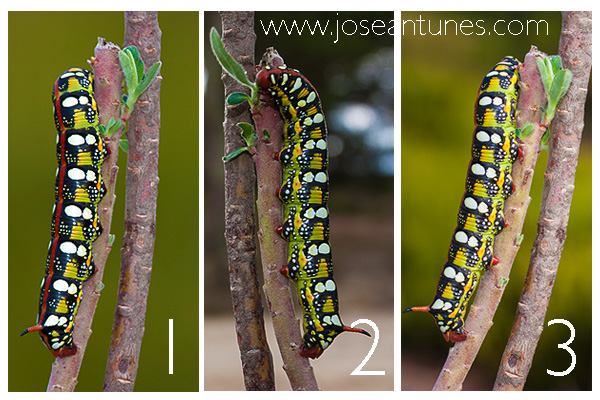Does EXIF data like speed, aperture and ISO give enough information to replicate a picture? This question arises every time people online ask others for that data. There is no simple answer to that, but there’s something for all of us to learn.

The numbered segments show sections of the caterpillar images taken with different lenses, but with the same exposure values. Can you tell which lens was used for what?
Some websites will ask you for the metadata on your images and not even let you post them without that information, defending it is important for people learning photography. Some even go as far as saying that you can write down whatever you think the picture was taken at, an option that frightens me. I rather not write anything and let people make an educated guess.

The exposure for this image was 1/250 f/6.3 at 100 ISO. But the exposure was the same on the images that follow.
While there is quite a lot of data written with each image these days, different programs will show different parts of it. And many programs that save images “for web” usually take away most of the info. You should also remember that some websites strip images of their EXIF data. Furthermore, some owners like to keep it secret, so they choose that option when saving the image. And, if you’re used to copying the original image and pasting it into a new document, as I usually do when I am preparing images for websites, then all the data is lost.
I do agree that the EXIF data (and EXIF is an acronym for Exchangeable Image File Format) is important for the photographer to understand how he or she made the image, but does sharing some of that info help others to learn photography?

When you “save for web” many programs will strip most metadata from the images.
I’ve asked this question to different people and I get different answers. Some will state it is essential while others believe, like me, it is more important for people to understand, from looking at an image, what the photographer decided. I mean, we all can see if an image is blurred, if the aperture was wide or small, and take our own conclusions from that.
Photographers coming from the days of film, I did not have any EXIF function to keep my data, so I wrote down the essential info about my pictures. It was such a standard practice for some, that one could buy special sheets of paper or notebooks with space to write data for each shot. The essential trio – aperture, speed, ISO – was present but also space to write notes about the conditions for the shoot. And when looking at pictures we would recall, more or less, the exact conditions at the time, and all the information could fit into place.

The exposure for this image was also 1/250, f/6.3 at 100 ISO, but this image was taken from another point of view.
A Little Game
I do think it is still good practice, for some work, to keep a “diary” that can have all the information the EXIF does not provide: weather conditions, special equipment used, like filters, manual flash, etc. And you can even go as far as drawing the setup created if it is important to keep. This “field diary” can be a valuable asset when you want to study your pictures and explain them to others.
Now, if I just post my images on the web and state the exposure trio data, is that of much help to others? Does it make it easier for them to do a photo like mine? Better said, does the EXIF data tell all the truth about a picture?
Let’s do a little game. Look at the picture on top, with numbered segments from the three caterpillar pictures under it. As you can see on the info on the different pictures, they were all taken at the same aperture, speed and ISO: 1/250 f/6.3, 100 ISO. Is that enough for you to make similar images?

Same exposure, and about the same point of view as the second photo. But, again, which lens was used here? Read on to know the answer.
I guess not. I must say this collection was made on purpose for this game or quiz, so I tried to keep the caterpillar the same size and keep the background at a distance to get about the same result. The image with the number three (3) was done with a 60mm macro lens. Image number two (2) was taken with a 17-40mm zoom lens on the 40mm setting, while image number one (1) was taken with a 100-400mm lens on the 300mm setting. All with a APS-C DSLR. As you see, just the information on the exposure does not tell the whole story.
So, the EXIF does not tell the whole story. Also remember that while with film the final image was the result of the exposure selected by the photographer, images edited in Photoshop may change, in terms of the final lighting, so what is shared on the web gives a different idea from what the EXIF metadata tells.
Now, do you still feel it is essential to share EXIF data with others? Or should it be part of a longer explanation that tells how the picture was created, from the taking moment to the editing in the computer?
via Phototuts+ http://photo.tutsplus.com/articles/photography-fundamentals-articles/quick-tip-does-exif-tell-the-whole-story/?utm_source=feedburner&utm_medium=feed&utm_campaign=Feed%3A+Phototuts+%28Phototuts%2B%29
Comentaris
Publica un comentari a l'entrada